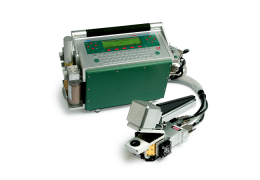Measuring Photorespiration with the LI-6400/XT System
Oxygen is a competitive substrate for ribulose 1,5-bisphosphate carboxylase/oxygenase (Rubisco), resulting in an inhibitory effect on net photosynthesis. Higher CO2 to O2 ratios inside the leaf decrease the Rubisco-catalyzed reactions with O2, resulting in less carbon-wasteful reactions in the light (photorespiration). Photorespiration increases on hot, dry days when evaporative stress can cause stomata to close, lowering the intercellular CO2:O2 as CO2 is assimilated. When Rubisco was evolved by plants, earth’s atmosphere had much higher concentrations of CO2 and relatively low O2. As plants evolved and filled different environmental niches, O2 production increased and atmospheric O2 concentration rose, thereby increasing photorespiration. C4-type plants such as maize and sugar cane evolved an active CO2-concentrating mechanism that increases the CO2 concentration near the site of the photosynthetic reactions, which suppresses photorespiration. Scientists and plant breeders are working to transfer this ability of C4-type plants into important C3-type plants such as wheat, rice and soybeans. One approach to studying and quantifying photorespiration is to suppress it by supplying the leaf with only 2% oxygen (instead of the normal 21% oxygen) and measure the increased rates of photosynthesis.
Experimental Setup
The diagram below shows a simple setup in which a tank of air with only 2% oxygen supplies the incoming air to the LI-6400/XT system. To prevent the LI-6400/XT internal pump from fighting against the external tank pressure, the tank supply is fed into the LI-6400/XT air inlet port via a T-fitting. One end of the fitting is vented to the atmosphere (through the flow meter in the diagram below) while the other flows into the LI-6400/XT. The tank air flow is adjusted so that it slightly exceeds the demand from the LI-6400/XT so that ambient air is not sucked in by the LI-6400/XT pump. Venting to the atmosphere also ensures that the system remains at atmospheric pressure. An inexpensive flow meter can be attached to the vented part of the T-fitting to check and make sure that the air flow is in excess of the demand from the LI-6400/XT pump.
The photograph below shows an actual setup with a tank of gas (air with 2% oxygen) for supplying air to the LI-6400/XT via a vented T-fitting. A float-type flow meter (taped to the side of the supply tank) is being used to test for excess flow.
This setup was used to test the differences between the response of Maize (a C4 species) and Bush Beans (a C3 species) to air with a 2% oxygen content and room air with the normal 21% oxygen content.
Results
The figure below shows the Bush Bean leaf (a C3 species) photosynthetic rate in response to varying Ci, the intercellular CO2 concentrations. At ambient CO2 concentration (Ci ≈250 ppm), photorespiration was reducing the net photosynthetic rate by about 40%.
The figure below shows the photosynthetic rate of a Maize leaf in response to varying intercellular CO concentration. In Maize (a C4 species), photorespiration is already suppressed by internal mechanisms, and supplying air with only 2% oxygen did not enhance net photosynthesis.
Conclusions
The simple modifications to the LI-6400/XT system’s operating procedure given in this Technical Tip provide one way to investigate photorespiration. The results of the basic experiment conducted to test this technique confirm that photorespiration accounts for a substantial reduction in the net photosynthetic rates of C3 plants. Efforts by scientists to transfer some of the ability of C4 species to suppress photorespiration into economically important C3 crop plants continue to hold great promise.




